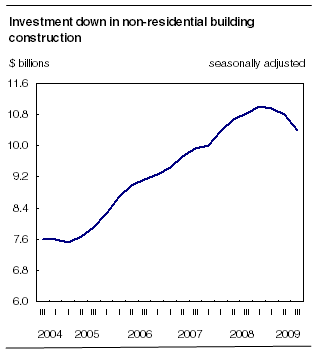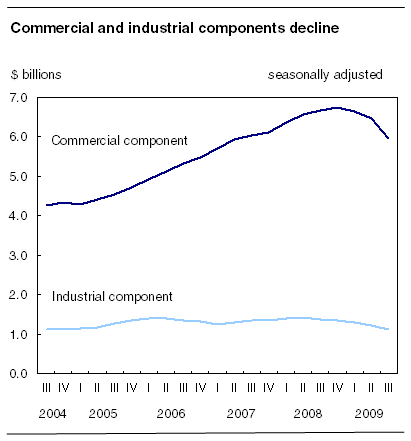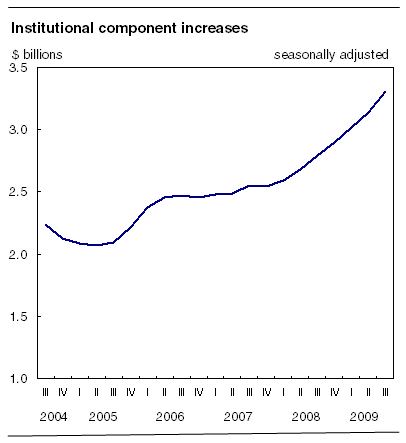Common menu bar links
Investment in non-residential building construction
Archived Content
Information identified as archived is provided for reference, research or recordkeeping purposes. It is not subject to the Government of Canada Web Standards and has not been altered or updated since it was archived. Please "contact us" to request a format other than those available.
Investment in non-residential building construction reached $10.4 billion in the third quarter, down 3.9% from the second quarter. This was the third consecutive quarterly decrease attributable largely to lower spending on commercial and industrial building construction.

Investors injected $6.0 billion into commercial projects, down 7.5% from the second quarter. For the industrial component, investment fell 8.8% to $1.1 billion.
In contrast, spending in the institutional component continued to rise, up 5.5% to $3.3 billion.
Note to readers
Unless otherwise stated, this release presents seasonally adjusted data, which ease comparisons by removing the effects of seasonal variations.
Investments in non-residential building construction exclude engineering construction. This series is based on the Building Permits Survey of municipalities, which collects information on construction intentions.
Work put-in-place patterns are assigned to each type of structure (industrial, commercial and institutional). These work patterns are used to distribute the value of building permits according to project length. Work put-in-place patterns differ according to the value of the construction project; a project worth several million dollars will usually take longer to complete than will a project of a few hundred thousand dollars.
Additional data from the capital and repair expenditures surveys are used to create this investment series. Investment in non-residential building data are benchmarked to Statistics Canada's System of National Accounts of non-residential building investment series.
For the purpose of this release, the census metropolitan area of Ottawa–Gatineau (Ontario/Quebec) is divided into two areas: the Ottawa part and the Gatineau part.
Of the six provinces that posted decreases in the third quarter, Alberta, Ontario and British Columbia reported the sharpest drops, mainly as a result of lower spending on commercial construction.
In contrast, New Brunswick posted the strongest quarterly increase, as a result of higher spending in the institutional and commercial components.
Investment fell in 17 of the 34 census metropolitan areas. The most pronounced decreases were in Toronto, Vancouver and Calgary, mainly because of the decline in commercial construction projects.
Ottawa–Gatineau (Ottawa part) posted the most substantial growth in the third quarter, with investment rising by 4.8% to $309 million. This increase was attributed to gains in all three components.
Decrease in the commercial component
Investment in the construction of commercial buildings declined for the third consecutive quarter. This decrease was the result of lower spending in Alberta, Ontario and British Columbia for office buildings, shopping centres and warehouses.
While nine provinces recorded decreases in commercial investment, the most significant declines occurred in Alberta (-13.2% to $1.4 billion), Ontario (-6.5% to 2.2 billion) and British Columbia (-10.8% to $785 million).

In contrast, New Brunswick, the Northwest Territories and Yukon showed increases in the commercial component, principally as a result of higher spending on office building construction.
Decline in the industrial component
Spending in the industrial component was down for a fifth consecutive quarter, in the wake of lower spending on the construction of manufacturing plants and utilities buildings in eight provinces.
Provincially, the most substantial contributions to the quarterly decline were those recorded in Alberta, where investment fell 19.9% to $216 million, and in Quebec, where it was down 13.1% to $250 million.
However, Manitoba and Nova Scotia posted strong increases in the third quarter, mainly because of higher spending on the construction of buildings for the primary sector.
Growth in the institutional component
Spending in the institutional component was up for a seventh consecutive quarter, mainly as a result of higher investment in educational institutions in eight provinces and the Northwest Territories.

Alberta showed the largest gain, as a result of higher spending on health and educational institutions.
In Quebec, higher investment in the construction of educational institutions more than offset the declines observed in the other categories of institutional buildings.
In contrast, Ontario posted the sharpest drop. This decrease was largely explained by lower spending on the construction of health care facilities and homes for the aged.
Available on CANSIM: table 026-0016.
Definitions, data sources and methods: survey number 5014.
More detailed data on investment in non-residential building construction are also available in free tables from the Summary tables module of our website.
For more information, or to enquire about the concepts, methods or data quality of this release, contact Bechir Oueriemmi (613-951-1165; bdp_information@statcan.gc.ca), Investment and Capital Stock Division.
Table 1
| Third quarter 2008 | Second quarter 2009 | Third quarter 2009 | Second quarter to third quarter 2009 | |
|---|---|---|---|---|
| Seasonally adjusted | ||||
| $ millions | % change | |||
| Total | 8,176 | 8,273 | 7,956 | -3.8 |
| St. John's | 44 | 60 | 48 | -20.0 |
| Halifax | 90 | 95 | 98 | 3.2 |
| Moncton | 45 | 40 | 43 | 7.8 |
| Saint John | 32 | 43 | 53 | 23.0 |
| Saguenay | 39 | 64 | 75 | 16.7 |
| Québec | 271 | 280 | 275 | -1.6 |
| Sherbrooke | 47 | 44 | 45 | 2.1 |
| Trois-Rivières | 50 | 45 | 51 | 12.9 |
| Montréal | 913 | 842 | 831 | -1.2 |
| Ottawa–Gatineau, Ontario/Quebec | 340 | 377 | 391 | 3.7 |
| Gatineau part | 53 | 82 | 82 | 0.0 |
| Ottawa part | 287 | 295 | 309 | 4.8 |
| Kingston | 83 | 70 | 61 | -12.7 |
| Peterborough | 22 | 27 | 23 | -13.1 |
| Oshawa | 96 | 112 | 100 | -10.5 |
| Toronto | 1,997 | 1,954 | 1,777 | -9.1 |
| Hamilton | 227 | 236 | 245 | 4.0 |
| St. Catharines–Niagara | 66 | 62 | 70 | 12.1 |
| Kitchener | 175 | 203 | 200 | -1.4 |
| Brantford | 19 | 30 | 33 | 11.9 |
| Guelph | 34 | 34 | 40 | 15.9 |
| London | 169 | 162 | 143 | -11.6 |
| Windsor | 62 | 46 | 53 | 14.1 |
| Barrie | 80 | 135 | 136 | 0.9 |
| Greater Sudbury | 59 | 59 | 54 | -8.1 |
| Thunder Bay | 25 | 38 | 29 | -24.0 |
| Winnipeg | 134 | 148 | 153 | 3.8 |
| Regina | 65 | 90 | 92 | 1.8 |
| Saskatoon | 145 | 193 | 184 | -4.5 |
| Calgary | 1,249 | 1,142 | 1,098 | -3.8 |
| Edmonton | 580 | 650 | 630 | -3.2 |
| Kelowna | 72 | 74 | 88 | 18.1 |
| Abbotsford–Mission | 62 | 41 | 36 | -11.4 |
| Vancouver | 798 | 760 | 670 | -11.8 |
| Victoria | 85 | 118 | 131 | 11.0 |
Table 2
| Third quarter 2008 | Second quarter 2009 | Third quarter 2009 | Second quarter to third quarter 2009 | |
|---|---|---|---|---|
| Seasonally adjusted | ||||
| $ millions | % change | |||
| Canada | 10,837 | 10,807 | 10,387 | -3.9 |
| Newfoundland and Labrador | 74 | 89 | 75 | -15.2 |
| Prince Edward Island | 23 | 36 | 32 | -10.6 |
| Nova Scotia | 160 | 171 | 169 | -1.3 |
| New Brunswick | 147 | 158 | 175 | 10.4 |
| Quebec | 1,836 | 1,842 | 1,844 | 0.1 |
| Ontario | 4,024 | 4,065 | 3,896 | -4.2 |
| Manitoba | 205 | 213 | 224 | 5.3 |
| Saskatchewan | 302 | 386 | 388 | 0.5 |
| Alberta | 2,686 | 2,505 | 2,305 | -8.0 |
| British Columbia | 1,353 | 1,305 | 1,222 | -6.3 |
| Yukon | 9 | 6 | 11 | 89.1 |
| Northwest Territories | 11 | 24 | 38 | 55.6 |
| Nunavut | 7 | 7 | 7 | 13.1 |

